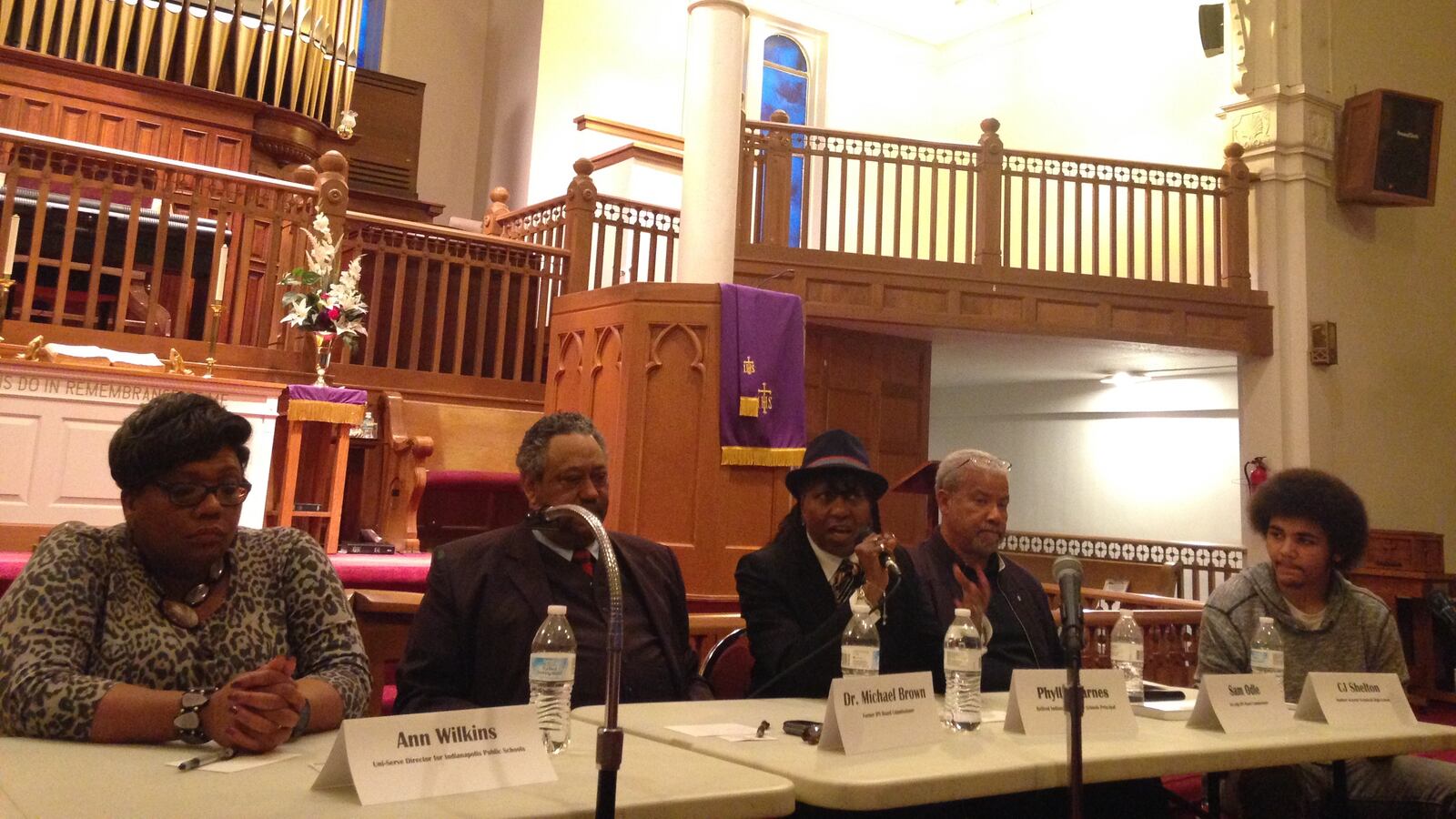Eight months after Indianapolis Public Schools rolled out a new approach to discipline designed to reduce suspensions, expulsions and arrests, some teachers and community members say it’s making schools more dangerous.
Last summer, district officials unveiled a new code of conduct and imposed sweeping changes to the way schools should discipline kids. Superintendent Lewis Ferebee called for an end to “zero tolerance” policies that expose kids to serious consequences for breaking relatively minor rules. Instead, Ferebee instructed schools to use positive intervention to reward students for meeting expectations. He also called for restorative justice programs that address misbehavior by encouraging students to help repair damage caused by their actions.
District leaders have heralded the success of this new strategy as a tool for reducing suspensions and keeping students in the classroom. But at a gathering yesterday sponsored by the NAACP, local education leaders raised impassioned concerns that the push to reduce suspensions is putting teachers and students at risk.
“I am hearing from a lot of places that the teachers don’t feel safe,” said Rhondalyn Cornett, head of the IPS teacher union. “I’m getting a lot of calls (and) a lot of emails.”
IPS says students are removed from classes if they are dangerous, but Cornett is not alone in her concerns. They were echoed by several speakers at last night’s NAACP event and the new policy has been criticized by community members during school board meetings.
Andrew Polley, an English teacher at Arsenal Technical High School who spoke to the school board February 22, told Chalkbeat that students have become unruly since the district began the push to reduce suspensions.
Without that threat, he said, there were five fights in the hall outside his classroom during the first half of this year.
“It was madness,” Polley said of the climate at the start of the year.
District officials said they do not have a single measure they use to track school safety, but Wanda Legrand, IPS deputy superintendent for academics, says IPS uses two yard sticks to judge whether school discipline policies are successful. District leaders look at whether schools are reducing punishments that lead to time out of school, such as suspensions, and they look at how school staff perceive the environment.
“We want every school to have a positive culture and a positive climate where teachers are excited to work in them and feel safe as well as students,” Legrand said.
The push to reduce suspensions and expulsions is part of a national trend away from “zero tolerance” or “no excuses” discipline, where students are punished for minor infractions. In the wake of a viral video of a New York City teacher yelling at a student and ripping up her work, the debate has flared across the country. In a recent story, Chalkbeat CEO Elizabeth Green suggested that no excuses might work, but it’s in need of reform.
One reason to cut suspension rates is because there’s strong evidence that some students face much harsher punishment than others. For example, although just 12 percent of Indiana students are black, they make up 40 percent of suspensions, according to Russ Skiba of Indiana University’s The Equity Project.
IPS began working with schools to plan for new discipline strategies last year, Legrand said. Schools were allowed to choose their own approach — either one developed internally or an existing standardized model, she said. Whatever model they chose, it had to be part of a plan for improving safety and behavior in school.
Suspensions, expulsions and arrests are all down this year, according to Legrand. But improving staff perception of school discipline has been a steeper climb. She has heard some negative feedback, she said.
The district is planning to survey educators about safety and other issues after spring break, Legrand said. Administrators hope the survey results will give them a clearer picture of where positive discipline is working and where schools need additional support.
Critics of the new discipline policy charge that teachers did not get enough training in the new model before IPS imposed it in schools. Polley said he could only recall a single, one-hour training session on restorative justice at Arsenal and many teachers at the school are not on board with new approach.
“You talk to the teacher and they don’t understand what restorative justice is,” said Ann Wilkins, an Indiana State Teachers Association staffer who works with IPS teachers. “I’m talking to teachers and administrators that say they haven’t been trained on that.”
Cindy Jackson, who is leading district work on improving school climate and discipline, acknowledged that some schools need a lot more support — including training and staff — to change their school cultures and discipline practices.
It’s big change for administrators and teachers because the district has not focused on social skills and positive support in the past, Jackson said. The district is in the first year of implementation, and it typically takes 3 to 5 years for school districts to build support for new codes of conduct.
“In the long run,” said Jackson, “it is going to help our students be successful and create safe environments.”
Arlington High School Principal Stan Law said that the school struggled to get discipline under control at the start of the year. With the help of several new staffers dedicated to behavior, however, the situation has dramatically improved.
A handful of newer teachers left the school mid-year because they felt unsafe, Law said. But other educators are comfortable, he said. The emphasis on avoiding suspensions has made him more thoughtful about whether to remove students from the classroom for less severe offenses.
“It just forces you to look at things in a different way,” he said.


